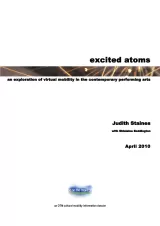Excited Atoms outlines a history of virtual mobility in performance, presents the main types of work with inspiring current examples, and traces some of the most critical issues and motivations for artists, cultural producers and promoters to collaborate, share, make, question, present and innovate using virtual mobility.
In depth interviews with 21 key practitioners, cultural managers and critical observers present informed points of view from around the world. A specially commissioned essay from Ghislaine Boddington (body>data>space) traces a personal pathway through creative collaborations in ‘performance telematics’. A Glossary explains some of the terms and helps demystify technologies and areas of creative practice. A final research section presents over 150 links to artists, projects, platforms, reading, and other references to extend the exploration of virtual mobility.
In 1980, on a November evening in Los Angeles, pedestrians who walked past the glass windows of the Broadway Department Store noticed something strange – they did not see their reflection. There were other people walking by, just not them. They ended up talking with the alien reflections and realised that they were in two different locations, indeed, on opposite sides of the country: at the Lincoln Center for the Performing Arts in New York City and the Broadway Department Store in Century City in LA. No signs, sponsor logos, or credits were posted – no explanation at all was offered. Hole-In-Space suddenly severed the distance between both cities and created an outrageous pedestrian intersection. There was the evening of discovery, followed by the evening of intentional word-of-mouth rendezvous, followed by a mass migration of families and transcontinental loved ones, some of whom had not seen each other for over twenty years.
Excited Atoms was written in 2009-2010, when digital performance and collaboration belonged to a small but passionate community. A decade later things have changed, but the central question of how we make work in, on and through digital means is still an open one.




